You have no items in your cart. Want to get some nice things?
Go shoppingManifesta 12 assigned itself the mission to leave Palermo a better city, and to empower its people. Curators made a conscious choice to hold events in spaces that are not usually dedicated to contemporary art: gardens and parks, churches, abandoned Palazzi, housing complexes, a refugee center. Most of the sites are within city limits, but a few — a scout base, the Pizzo Sella ghost housing development, Gilles Clément’s garden in the ZEN housing project – are a few hours away by foot, less by car, as kindly indicated in the Biennial’s guide. Each location gets a detailed description, on the same footing as the work exhibited. Casa del Mutilato (Center for the War Wounded), a fascistic era building, displays bombastic columns, metal eagles and 30s murals to the glory of war and soldiers. Its main space hosts a video triptych, Unending Lightning, by Cristina Lucas. Civil casualties statistics, archival footage and photographs log every single bombing since 1945, and the sum total is devastating. An embroidered silk tapestry maps World War II bombings in Europe. Another video, projected near framed photos from the fascist era, follows a plane pulling a banner of “L =(1/20 d v2 s L),” the formula which enabled flying. Because of its military related purpose, the whole venue becomes an installation where the work dialogues with the surroundings, delivering with poignancy the absurd cost of war. This exhibit belongs to the “Out of Control Room” theme, one of three that inform the Biennial, while the “Garden of Flows” section offers solutions to rein the world back into harmony. Works with the theme, “City On Stage,” investigate Palermo and simultaneously make propositions for an enlightened future. Palazzo Forcella de Seta and Palazzo Ajutamicristo (literally Help Me Christ) also host exhibits that denounce our “Out of Control Room.” In the Palazzo Ajutamicristo, yet another grand dilapidated building , it’s unclear whether the graffiti was contributed by the artists on show or existed before.
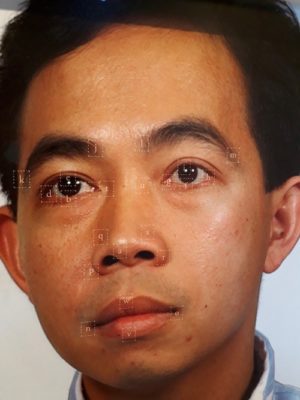
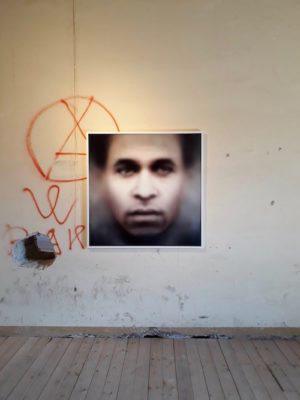
Trevor Paglen contributes to the critique with several works, including Fanon (Even The Dead Are Not Safe), a portrait of late thinker Frantz Fanon. As only the features taken into account by the algorithm enabling face recognition are rendered, in a kind of reverse process, the blurred illusion of his face contrasts with the vivid person he was, with his very real post-colonial thought. A different computation is responsible for the circular projection on the ceiling, Connected By Air, by Richard Vijgen. It traces in real time the composition of the sky over Palermo, including data, wireless waves, chemicals, air flow. Mesmerizing and worrisome at the same time. The installation ironically mimics baroque representations of the celestial realm at a time when only clouds and Gods occupied our heavens. His work, as well as Manifesta 12 as a whole, could be defined as “Art Utíl,” a discipline founded by Cuban artist Tania Bruguera. She has been collaborating with Italian activists to oppose MUOS, the US Navy surveillance installation located in Sicily. Activists have protested its implementation from the get-go, and locals claim the radiation is killing the surrounding fauna as well as harming the health of humans. Bruguera narrates this story of resistance through an installation of related documents and a populist mural. Her exhibits, as well as the other work in the “Out of Control Room,” chillingly question the responsibility of the systems and networks involved, and governmental abuse.
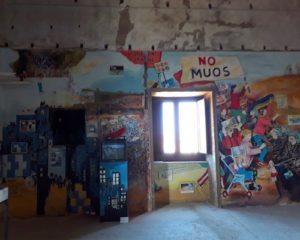
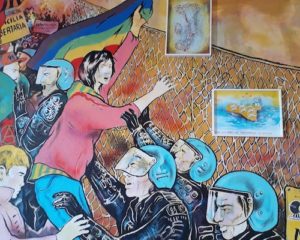
As an antidote to the dysfunction, the collaborative piece Across The Border, 30 flags, exhibits flags devised to bring people together rather than split them along nationalistic lines: a flag celebrating “Hormones” was created by an artist in Beirut, Beleaf is from India, Utopia from Spain, Woloff, the African Lingua Franca, from Nigeria.
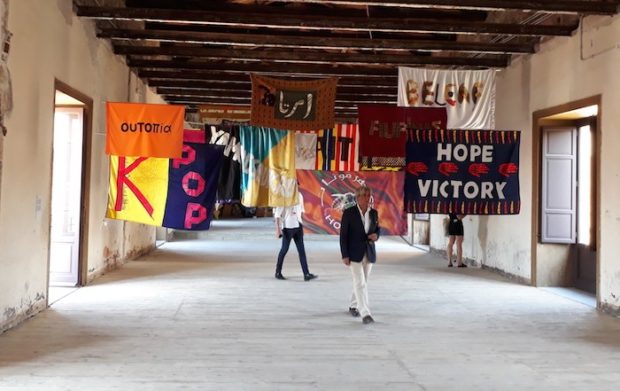
But the respite is brief, as visitors are faced with accounts of the tragedies on the Mediterranean. A 3d model animation created by Goldsmith College aims at clearing a rescue boat operation, accused of collusion with engine hunters that roam the sea for boats to plunder. These NGOs are the butt of legal harassment, as the rescued migrants they seek to protect inconvenience both European countries and the Libyan Navy. The latter gets concrete incentives from Italy to capture refugees and jail them in their prisons where they are ill-treated, a despicable form of headhunting.
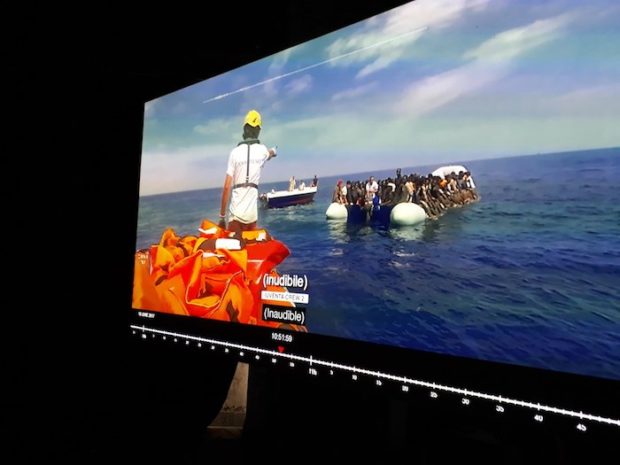
This conflict of interest is also documented in a film using unique footage from an NGO, where the volunteers and the Libyan navy crew fight over refugees. As they are beaten with plastic tubing, men captured by the Libyans try to jump from the Libyan Navy vessel , trying deperately to reach the NGO’s boat that will bring them to the land of promise, Italy. A melee ensues in which several refugees drown. On camera. Visitors wipe tears discretely, here and in front of other works as devastating, . Through the gallery’s window, they catch a glimpse of the Mediterranean, a perfect hue of blue on this sunny day. Statistics presented in the same gallery discloses that over 10’000 migrants have drowned in its quiet waters in the last five years. The exhibits bring home to the visitor that every refugee working as staff for Manifesta 12, or taking part in a performance, or walking in the street, every young African smiling, chumming it up, playing soccer on a Saturday afternoon, has gone through the deadly ordeal of that journey. Data, money, goods – seeds even – move freely across borders with little protest, objects Manifesta in its publications, but migrating humans incite all the outcry because of their unfortunate visibility. Concomitantly, migration is defined as a form of movement that includes suffering, either as a cause, or as a consequence.
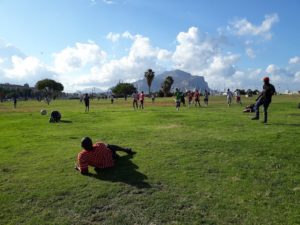
In comparison to the documentation of the tragic lot of migrants, some pieces might come across as mundane. A documentary tells of the bonds between Palermitani and films, such as the famous Leopard by Lucchino Visconti. The projection takes place on a truckbed in the inner court of a dilapidated palace. This venue is illuminated by the story of Visconti’s conflicted nostalgia for an aristocratic world that he, both count and communist, thought should justly disappear. The truck is scheduled to drive out through the large coach doors and offer its video content to local communities around Palermo.
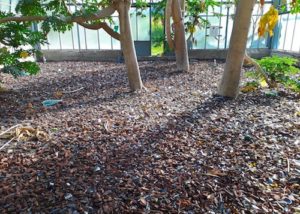
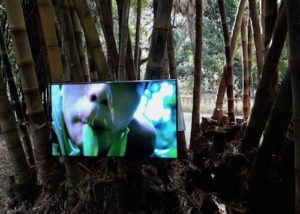
The Botanical Garden belongs to the more uplifting “Garden of Flows.” It would be worth a visit even if it weren’t for the Biennial, with its lush foliage, its lemons rolling at the feet of the visitors, its fountains, its ponds, its carefully aligned terra cotta pots. Some of the exhibits belong to the familiar realm of contemporary material: gorgeous photos of plant imprints in coal, Drowned World, by Michael Wang; a video, Pteridophilia by Zhen Bo, playing on a screen set in a bamboo groove, shows young men making love to ferns; an installation by Lungiswa Qgunta, Lituation, of a plot of the garden defiled by dirty broken bottles and glass shards, sounds a desolate note of contamination and danger, whether the victims are humans, animals or the environment. Others are more unusual, such as Leone Contini’s ‘intervention’ Foreign Farmers, which documents and collects the seeds of plants introduced by migrants, as they might adapt better than native species to our changing climate. Two installations, if they can be called that, in Michael Wang’s Drowned World, hint at the ephemerality of our human race: a foaming, acid-green water in a fountain reproducing at the same time the conditions of chemical wasteland and those of the sea at the emergence of life. Species, the same that produced fossil fuels billions of year ago, have been planted in old gas tanks to accelerate their disintegration. Should we go on with our fossil fuel habit, the planet might well go back to hosting only these primitive organisms. The NGO sponsoring this work claims to be “philanthropic” by providing clean water to communities. This terminology, when Manifesta works so hard at promoting the concept of a “Planetary Garden” in the Anthropocene, sounds shockingly outdated. Michael Wang and Leone Contini’s works, like many of the installations around the city, merge seamlessly with the locations, some to stay, as Manifesta has been active in several Palermo locations for a whole year.

In the busy center, activists give out information about a march from Sicily to Brussels to protest the treatment of refugees. They seem to have no direct affiliation with Manifesta 12 but nevertheless fit nicely in its nest. On the same street, a line has formed in front of a church’s porch. Those who make it to the front of the line get to peek through an octagonal glass window. Inside, mysterious poster boards, their content undecipherable from the peephole, line both sides of the center aisle. No Manifesta signage or posters identify the site. The peepers, mostly Palermitani, explain their interest by the fact that the church is usually boarded up. On the wall of a townhouse, a large canvas shows a man stranded at the top of an escalator: he is surrounded by wilderness. No signs here either, but there is little doubt the piece is part of Manifesta 12, and should belong to the “City on Stage.” A small public garden right in the busy center of town, Il Giardino dei Giusti, prides itself in its elegant antique ruins. With its citrus trees covered in yellow netting, this installation brings attention their precious beauty and complexity, created by that most excellent artist, Nature. At the same time, the netting turns the trees into ghostly figures, hinting at their fragility. Adding one more layer of meaning, a text informs us that the netting retains humidity while allowing the sunlight through. This results in a lesser need to water, a resource that has been fought-over heatedly in Sicily, as in other parts of the world. It is one element in the What is Above Is What Is Below intervention by artists Daniel Fernandez Pascual and Alon Schwabe. Whimsical and pragmatic at the same time, they have put together a “CLIMAVORE” bag with drought resistant ingredients that is offered for free in a number of locations. On a vast piazza, a bus all decorated in vegetal patterns has been revamped to host an education hub. In front of the bus, in the balmy spring weather, the two artists propose dramatic cooking lessons, with unusual vegetables, and large, mythical pots. These, as well as the workshops for children, are well attended.
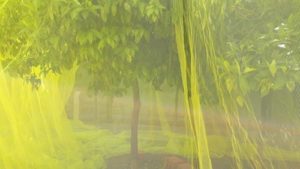
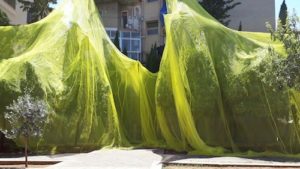
Palazzo Butera also hosts the “Garden of Flows.” In the experimental video Night Soil, Melanie Bonajo explores Westerners’ fraught relationship to nature. A young woman offers casual sex to men in New York City as a tantric practice. While this activity might be condemned by various systems of thought and ethics, its generosity cannot be denied. In a very different documentary, a Sicilian woman tells of her activist past: resistance under German occupation, activism on behalf of workers as a communist, then by extension on behalf of women, and finally with women against the mafia. Her testimony is particularly touching in its modesty, in its matter-of-fact descriptions of activities that changed the face of Sicily and belong now to History. The video is part of an installation by artist Uriel Orlow entitled Wishing Trees, and the activist’s skin does resemble the weathered bark of the tree featured in a large photograph nearby. Both have lived long and seen a lot.
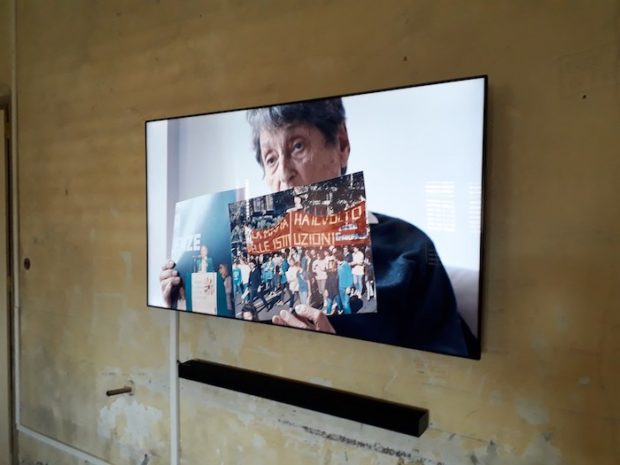
Many of the videos presented can be described as straight documentaries that would not usually belong in a contemporary art gallery. Holding the projections and exhibitions in unlikely venues not only adds narrative, but also ensures that the art is noticed by people who might not visit galleries. Exhibition after exhibition, intervention and intervention, performances, installations, panels come together to realize a “planetary garden” from every angle and in every direction. The artistic work on show questions war, borders, injustice, the past, the present, the future, sustainability, ecology, in a way that is both extensive and convincing, in an environment of stunning beauty. In fact, the whole city of Palermo is turned into a huge work of art. Or, as one might argue that it already was a work of art, with its beautiful architecture combining styles from every culture, its sumptuous vegetation and its diverse ethnicity, Palermo becomes under our eyes one monster installation, pulsating and breathing fire.
Touches of humor pepper the exhibits, a relief from the emotional intensity. A mock documentary describes in depth the “Incompieto” style – as yet another architectural style – as one would speak of “Gothic” or “Italianate.” “Incompieto,” most prominent in the 20th Century in Italy, defines buildings that have been planned but never built, built but abandoned at an early age, or not quite completed or occupied. Less amusing is the reason for this Italian trend: corruption that diverted the state funds into private pockets in a mutually agreeable arrangement between the ruling class and the mafia. The “Cosa Nostra” has lost a lot of its power in Sicily, downgraded to a small-time criminal gang. The Mayor of Palermo, Leoluca Orlando has been instrumental to this demise. Not only did he fight the mafia in the 80s, but he survived to tell the tale and won, thanks to the involvement of the Sicilian women. During his dynamic tenure in the city, he’s made a huge impact on the city’s economic and political situation. He also supports the abolition worldwide of residency permits, a policy that would allow people to move freely. This open arm attitude toward migrants has not impeded his reelection: he won with over 70% of votes.
In The Guardian Apr 18, 2017, Orlando declared, “We needed time to abolish slavery, we needed time to abolish the death penalty. But in a globalised world, where there is free movement of goods, money and information, free movement of people is ultimately inevitable.” He argues that keeping people in an illegal state makes them vulnerable to the criminal world. What is left of the Mafia has been preying on destitute migrants, who get hired for the dirty work: drugs and sex trafficking.
Mayor Orlando invited Manifesta to Palermo with the hope the teams would come up with tools for further change. Additionally, smart cookie that he is, he knew that an influx of art professionals bringing work to local vendors and tradesmen, and of foreign visitors, in majority from Northern Europe, spending Euros in hotels and restaurants, has never hurt a city’s finances.
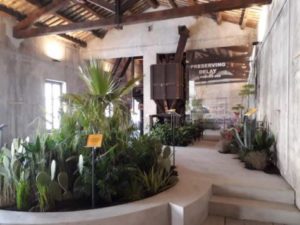
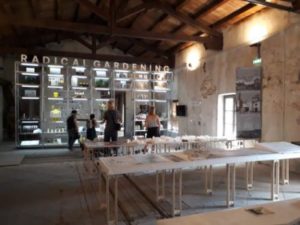
For the 12th edition of Manifesta, nearly fifty artists or artist collectives presented works, often multiple, around twenty locations. And that is the tip of the iceberg. While Palermo is teeming with exhibitions and shows as the Italian Capital of Culture for 2018, Manifesta has further developed one of its branches. “Collateral Events,” also known as “5x5x5,” work as a bridge between the international reach of the main manifestation and the local communities. Five artists were paired with five educational institutions and five international galleries. Their interdisciplinary teams are to benefit from the resources of the Biennial and prolong its legacy beyond its five months span. Covering the results of these collaborations is beyond the scope of this article, but here is a telling sample of their designation: Counter-Colonial Aesthetics; Border Crossing; In Liberty We Trust; Politics of Dissonance; Confiscated Properties: Architecture, Ideology and Performance – this team uses properties confiscated from the mafia to hold community events and performances.
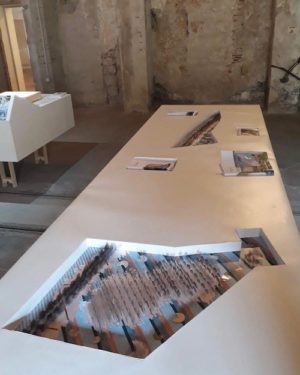
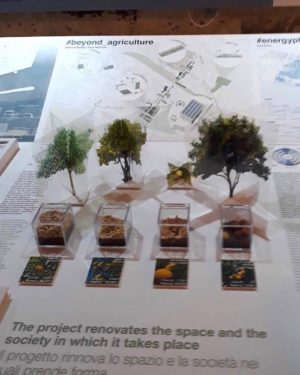
As if that weren’t enough, teams from four architecture schools, “Manifesta 12 Studios,” were asked to come up with urbanism blueprints for Palermo. Their collaborative efforts investigated the city and the needs of its inhabitants. The result of their work is displayed in the attic of the architecture school, complete with an extraordinary wood and iron mechanism that must have been in use when the building was still the mill of San Antonino. The concrete, imaginative methodologies are illustrated in a synergetic way that blends the aesthetic, the emotional, and the analytical, whether it involves a large indoor plant bed or delightful miniature models. These proposals, as well as the findings from their research, have been published in Palermo Atlas, a highly original cross between a book and a magazine. The official publication of Manifesta 12, it offers an ecological deciphering of the city, defined as located both in South Europe and Northern Africa. The editors transliterated the works presented in situ by adding illustration to the content, including graphics and maps. The style “Incompieto” has its own chapter, for our further delight. The past is also explored through memories such as the interview of an 83 year old woman who pioneered as a photojournalist. A beautiful photo essay documents the migrants’ rituals now taking place alongside the traditional Catholic liturgy. The whole publication is graced by the same elegant graphical style as the Biennial’s signage: a sober, “utíl” font, a palette of primary reds and greens, digital motifs, gestural brush strokes.
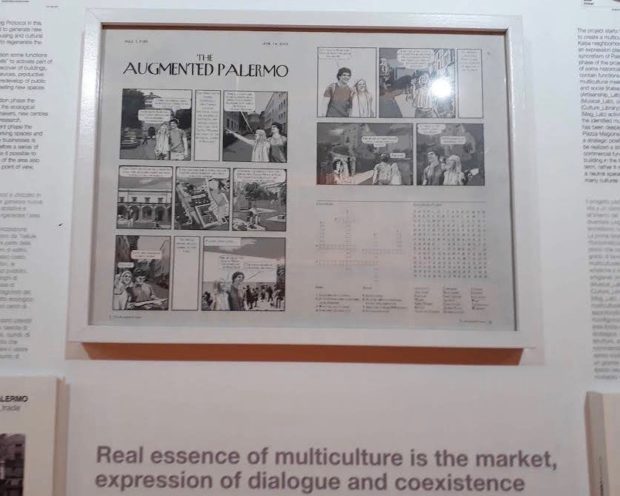
Not so long ago, at the 2016 edition in Zürich, the Biennial offered a self definition that was rather modest: “Since Manifesta’s inception in the early 1990s its mission has been to examine the cultural topography of Europe.” Manifesta 12, by merging the artistic with the social, has aimed at leaving a much deeper mark. The global political situation as described by the works at the Biennial can be conceptualized as sitting at a cusp. Depending on the action of the players, international corporations in collusion with governmental surveillance and military arms will keep controlling everything, from natural resources to the minds of people, in the race for more power and profit. The activists, artists, scientists, thinkers, curators that have come together at Manifesta 12 show the way to a very different model, one which will sustain every being on the planet whether human, animal, vegetal or mineral, and that includes the magnificent decaying palaces of Palermo.
Visitors to the biennial leave with the most precious good in their luggage, one that they share with the young migrants in Palermo: hope. While the refugees aspire to a better life, the visitors gain, or regain, the faith that a better world is possible. The intense maelstrom experienced at Manifesta 12 by Sicilians, Europeans and visitors from all regions might achieve what emotions do by etymology: move one to action.
Read Part 1: Manifesta 12: Opening Rights Speak to Our Common Humanity
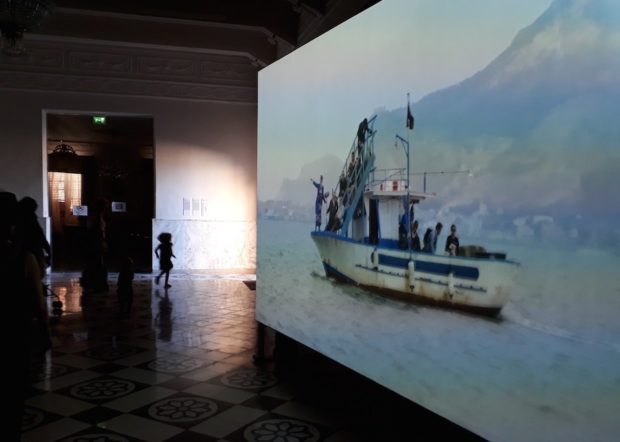

About Arabella Hutter von Arx
Arabella Hutter is a writer with a particular interest in women issues and the arts. She writes articles about art and literature for magazines, pieces about New York City for European newspapers, and her fiction is represented by Lotus Lane Literary. She has a background as a film and television writer/producer whose work includes films and documentaries for the British Film Institute, the BBC, and Channel 4, in addition to several international independent and experimental films. She collaborated on 14 episodes of "Inside the Actors' Studio" for Bravo with Glenn Close, Jessica Parker, Holly Hunter, Gene Wilder, and more. She was the Executive Director of The International Quorum of Motion Picture Producers from 2012 to 2015. Raised in Switzerland, based in Brooklyn, she travels the world on a regular basis with a preference for India, Thailand, Turkey, and Italy.
- Web |
- More Posts(3)





An excellent article that manages to describe both the contents and ethos of what sounds like a sprawling, exciting, and at times dispiriting exhibit. By detailing the ways in which art and politics are intersecting these days, Hutter manages to express her sympathy for the artists’ aims without in any way appearing partisan or dogmatic. This is sophisticated reportage that manages to blend the subjective and the objective without descending to the current trend toward utter opinion. Hutter manages to take those of us who can’t get to Palermo there in spirit. Beautiful work.
A very informative article that clearly expresses the intent and purpose of the exhibitions and projections at the Manifesta 12 Palermo. Plenty of sociopolitical art for one’s edification; a wealth of visual commentary to emotionally and mentally digest.
This was some thing so useful to me here. https://www.wattpad.com/630967299-clash-royale-hack-free-gems-cheats-free-clash